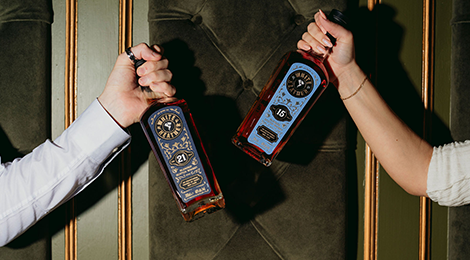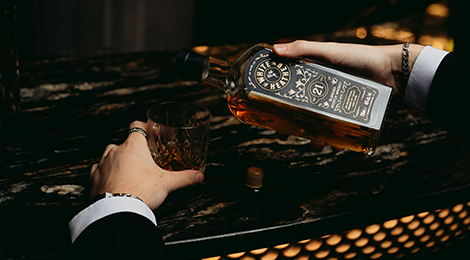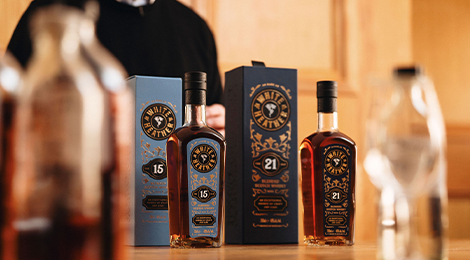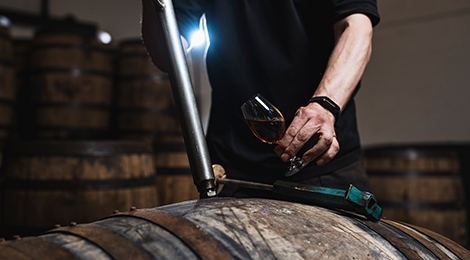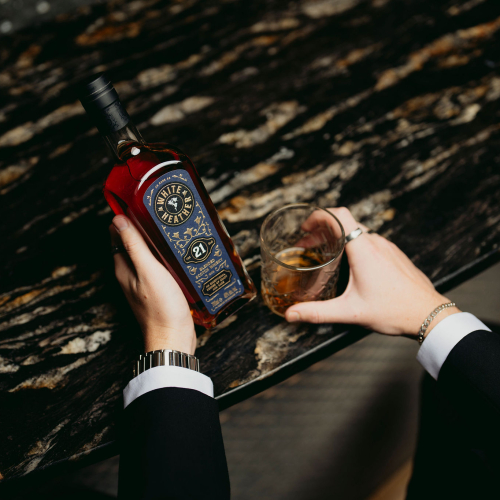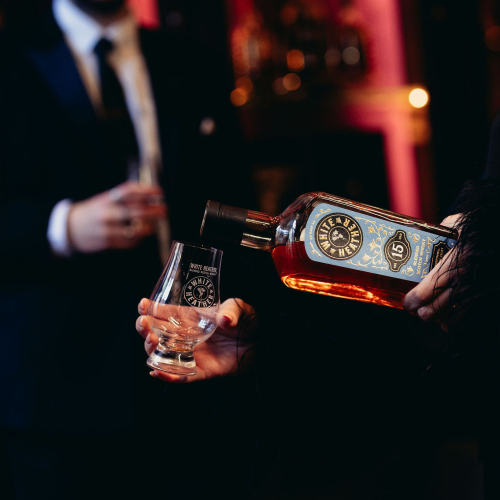The Whisky Guide
A protected spirits category since the 1990s, Scotch whisky must abide by defined production parameters to meet the definition. Protected by the Scotch Whisky Association (SWA), Scotch whisky must be produced, aged and bottled in Scotland; matured for a minimum of three years in oak casks; and presented at 40% ABV or higher.
Definitions
Scotch Whisky
A type of whisky made in Scotland from barley or other grains, water and yeast. It must be aged in Scotland for a minimum of three years in oak casks and bottled in Scotland at 40% ABV or higher.
Malt Whisky
This designation indicates that malted barley, water and yeast were the raw materials used, and the spirit was distilled in a pot still.
Grain Whisky
This description stipulates that grain (e.g., wheat, corn, maize or unmalted barley), water and yeast were the raw materials used, and the spirit was distilled in a column still.
Single Malt Whisky
Malt whisky distilled at one distillery.
Single Grain Whisky
Grain whisky distilled at one distillery.
Blended Malt Whisky
A blend of single malts from more than one distillery.
Blended Grain Whisky
A blend of single grains from more than one distillery.
Blended Scotch Whisky
Traditionally, it is a blend of malt and grain whiskies from multiple distilleries at varying proportions; however, it is also possible that the malt and grain whiskies were produced on the same site.
Barley
A type of cereal grain.
Malted Barley
Barley that was steeped in water and spread out on a malting floor. It is then dried to halt germination. For peated barley, the kiln used for drying is fired by peat to create a smoky flavour contribution. The malting process converts stored starch into soluble compounds that can be used in whisky production.
Peat
Partly decomposed organic matter, derived predominantly from plant material, that grows in peatlands at a very slow rate over many years.
Yeast
A living, single-cell organism which converts sugar into alcohol and carbon dioxide through the process of fermentation.
Milling
Where dried malt is turned into a flour-like grist which makes the sugars more accessible for whisky production.
Mashing
The stage where the grist is moved to a mash tun and hot water is added to facilitate a chemical reaction that creates fermentable sugars. The resulting liquid is called the wort.
Fermentation
The process of adding yeast to the cooled wort and allowing the yeast to eat the sugars and produce alcohol. The subsequent liquid is called the wash.
Distillation
A separation technique which involves boiling a solution and condensing the vapour to separate components from a mixture based on their boiling points.
Pot Still
A pear-shaped vessel, typically made of copper, used for batch distillation. Two different types are required: wash stills and spirit stills.
Column Still
A tall, straight cylindrical column capable of continuous distillation. They are much more efficient than pot stills.
New Make Spirit
The name given to freshly distilled spirit before it enters a cask for maturation.
Cask
An oak container used to hold whisky while it matures. Often, the cask previously held another spirit or wine (e.g., Bourbon or Sherry), but brand-new casks, called virgin oak, can also be used. It is widely believed that the cask delivers around 70% of the resulting whisky’s flavour.
Maturation
The stage where the whisky is left for a minimum of three years in oak casks to develop flavour characteristics from the wood and, sometimes, a darker colour.
Angel's Share
The name given to the alcohol (around 2% per annum) which is lost to evaporation during maturation.
Marrying
This is where multiple maturing casks are mixed together either to be refilled into casks for further maturation or to be bottled.
Re-racking
A term referring to a whisky being transferred from one cask to another for a secondary maturation period.
First-fill
This label is given to a cask which is being filled with whisky for the first time (but may have previously held something else, such as Bourbon or Sherry).
Refill
A term used for a cask which has already been used to mature whisky before.
Age Statement
The age of the youngest component whisky at the time of bottling. Expressions that do not declare their age are called non-age statement (NAS) whiskies.
Chill Filtration
An optional process used by the majority of Scotch whisky producers which occurs before bottling and involves chilling the whisky to around 0⁰C and passing it through a fine filter. This removes naturally occurring esters and long-chain fatty acids that become a solid form at such a temperature. The rationale is typically to avoid whiskies bottled below 46% ABV forming a haze (which is completely normal, as the aforementioned compounds are insoluble in lower ABVs, but it may be visually off-putting to the drinker) in cool conditions, or with the addition of water or ice. The process guarantees clarity and brightness, but it is widely argued it can remove flavour and texture.
Natural Colour
When the whisky inside the bottle is presented without adding artificial colouring (E150a). In these cases, the colour is naturally occurring and has developed over time in the cask.
ABV
Shorthand for alcohol by volume, ABV is a measure of the level of pure alcohol, or ethanol, that exists within a liquid.
Master Blender
A person with many years of experience entrusted with blending malt and/or grain whiskies together to make an expression with carefully considered characteristics.
Scotch Whisky
A type of whisky made in Scotland from barley or other grains, water and yeast. It must be aged in Scotland for a minimum of three years in oak casks and bottled in Scotland at 40% ABV or higher.
Malt Whisky
This designation indicates that malted barley, water and yeast were the raw materials used, and the spirit was distilled in a pot still.
Grain Whisky
This description stipulates that grain (e.g., wheat, corn, maize or unmalted barley), water and yeast were the raw materials used, and the spirit was distilled in a column still.
Single Malt Whisky
Malt whisky distilled at one distillery.
Single Grain Whisky
Grain whisky distilled at one distillery.
Blended Malt Whisky
A blend of single malts from more than one distillery.
Blended Grain Whisky
A blend of single grains from more than one distillery.
Blended Scotch Whisky
Traditionally, it is a blend of malt and grain whiskies from multiple distilleries at varying proportions; however, it is also possible that the malt and grain whiskies were produced on the same site.
Barley
A type of cereal grain.
Malted Barley
Barley that was steeped in water and spread out on a malting floor. It is then dried to halt germination. For peated barley, the kiln used for drying is fired by peat to create a smoky flavour contribution. The malting process converts stored starch into soluble compounds that can be used in whisky production.
Peat
Partly decomposed organic matter, derived predominantly from plant material, that grows in peatlands at a very slow rate over many years.
Yeast
A living, single-cell organism which converts sugar into alcohol and carbon dioxide through the process of fermentation.
Milling
Where dried malt is turned into a flour-like grist which makes the sugars more accessible for whisky production.
Mashing
The stage where the grist is moved to a mash tun and hot water is added to facilitate a chemical reaction that creates fermentable sugars. The resulting liquid is called the wort.
Fermentation
The process of adding yeast to the cooled wort and allowing the yeast to eat the sugars and produce alcohol. The subsequent liquid is called the wash.
Distillation
A separation technique which involves boiling a solution and condensing the vapour to separate components from a mixture based on their boiling points.
Pot Still
A pear-shaped vessel, typically made of copper, used for batch distillation. Two different types are required: wash stills and spirit stills.
Column Still
A tall, straight cylindrical column capable of continuous distillation. They are much more efficient than pot stills.
New Make Spirit
The name given to freshly distilled spirit before it enters a cask for maturation.
Cask
An oak container used to hold whisky while it matures. Often, the cask previously held another spirit or wine (e.g., Bourbon or Sherry), but brand-new casks, called virgin oak, can also be used. It is widely believed that the cask delivers around 70% of the resulting whisky’s flavour.
Maturation
The stage where the whisky is left for a minimum of three years in oak casks to develop flavour characteristics from the wood and, sometimes, a darker colour.
Angel's Share
The name given to the alcohol (around 2% per annum) which is lost to evaporation during maturation.
Marrying
This is where multiple maturing casks are mixed together either to be refilled into casks for further maturation or to be bottled.
Re-racking
A term referring to a whisky being transferred from one cask to another for a secondary maturation period.
First-fill
This label is given to a cask which is being filled with whisky for the first time (but may have previously held something else, such as Bourbon or Sherry).
Refill
A term used for a cask which has already been used to mature whisky before.
Age Statement
The age of the youngest component whisky at the time of bottling. Expressions that do not declare their age are called non-age statement (NAS) whiskies.
Chill Filtration
An optional process used by the majority of Scotch whisky producers which occurs before bottling and involves chilling the whisky to around 0⁰C and passing it through a fine filter. This removes naturally occurring esters and long-chain fatty acids that become a solid form at such a temperature. The rationale is typically to avoid whiskies bottled below 46% ABV forming a haze (which is completely normal, as the aforementioned compounds are insoluble in lower ABVs, but it may be visually off-putting to the drinker) in cool conditions, or with the addition of water or ice. The process guarantees clarity and brightness, but it is widely argued it can remove flavour and texture.
Natural Colour
When the whisky inside the bottle is presented without adding artificial colouring (E150a). In these cases, the colour is naturally occurring and has developed over time in the cask.
ABV
Shorthand for alcohol by volume, ABV is a measure of the level of pure alcohol, or ethanol, that exists within a liquid.
Master Blender
A person with many years of experience entrusted with blending malt and/or grain whiskies together to make an expression with carefully considered characteristics.





